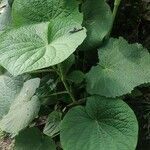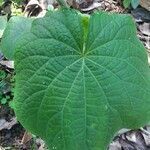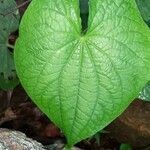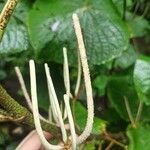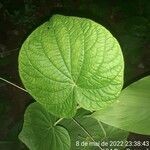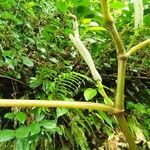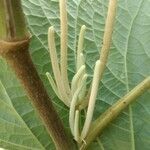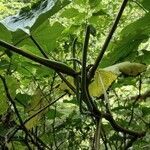Subshrubs erect, 1-2 m high. Stems thick, strong, striated. Petiole 15-25 cm, glabrous or ± hispidulous; leaf blade ovate or suborbicular, 17-37 × 15-32 cm, membranous, densely brown glandular, glabrous, or hispidulous along veins, base deeply cordate, ± bilaterally symmetric, apex mucronate or obtuse; veins 11-13, apical pair arising 1-2 cm above base, ± opposite, others basal. Flowers bisexual. Spikes (1-)2-7 in umbel-like clusters on short, axillary branches. Spikes 2-7 per umbel, 7-12 cm; peduncle of umbels thicker and longer than those of spikes; bracts triangular, ca. 1 × 0.5 mm, peltate, stalked, margin ciliate. Anthers much longer than filaments. Drupe obovoid or cuneate-obovoid, 0.7-1 × circa 0.5 mm, glandular. Fl. Nov
Aromatic shrub to 3 m high. Leaves: petioles to 30 cm long, shortly sheathing nodes, short-hairy; lamina broadly ovate to suborbicular, subpeltate, to 40 cm wide, cordate at base, acute, acuminate or rounded at apex, short-hairy on nerves, minutely ciliate on margin; veins c. 15 radiating from base, one pair above, the remainder arising from midvein. Spike erect, cylindrical; rachis to 11 cm long; peduncle 0.3–1.5 cm long; up to 15 spikes arranged umbellately on an axillary peduncle. Flowers bisexual; bracts triangular, margin conspicuously white-ciliate. Stamens 3. Stigmas 3, sessile. Fruit ± obovoid, 0.7–1 mm long, free.
Leaf lamina (5)6–36(40) ? (4.5)6–32(42) cm, subcircular to reniform, ± shortly acuminate at the apex, deeply cordate at the base, membranous, with a mint-like fragrance, discolorous, dark green and slightly shining above, lighter green below and ± glandular-punctate, sparsely to densely pubescent on the nerves above and beneath and also on the conspicuously reticulate venation beneath, ± ciliate at the margins; nerves 11–13(15), palmate, impressed above and prominent below, reticulation conspicuous below.
A small shrub. It is erect and 1-2 m high. The stems are thick, strong and with lines along them. The leaf stalk is 15-25 cm long. The leaf blade is oval and 17-37 cm long by 15-32 cm wide. They are like a membrane. They have brown glands. The base is deeply heart shaped. There is a sharp tip. There are 11-13 veins. The flowers have both sexes. The spikes are 2-7 together in clusters on short stalks in the axils of leaves. The spikes are 7-12 cm long.
Inflorescences glabrous, consisting of 2–8 spikes umbellately arranged on reduced leafless axillary shoots 4–12 cm long; umbel bracts up to 8 mm long, deciduous; spikes (4)5–10(12) cm long and c. 0.3 cm in diameter, bright greenish-white, glabrous, with slender peduncles 0.4–1.7 cm long.
Flowers bisexual; floral bracts 0.5 mm across triangular to ± subcircular, distinctly white fimbriate at the margins, petiolulate; stamens 2; stigmas 3.Fruit c. 0.6–0.8 ? 0.4–0.5 mm, obpyramidal, trigonous, brownish when ripe, glandular-punctate.
Petiole up to 30 cm long, dilated and amplexicaul at the base, grooved above, terete beneath, glabrous, glandular-punctate.
A shrub up to 3(4) m high, with numerous stems arising from a woody rootstock, becoming scrambling.
Stems subsucculent, thick, slightly striate, glabrous, with adventitious roots.
A shrub, 4–6 ft. high
White narrow catkins
